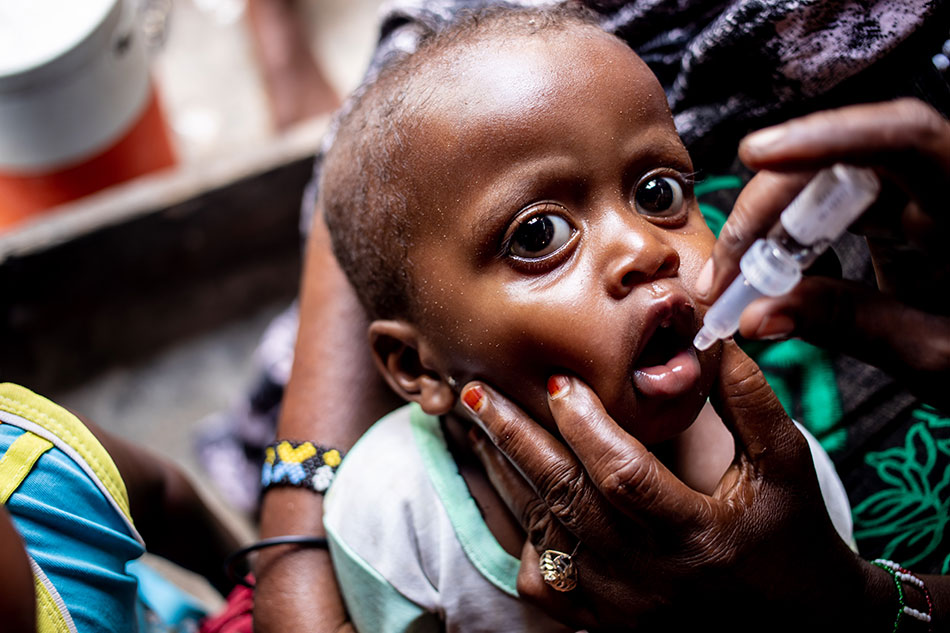
Somalia, located in the Horn of Africa with an estimated 15.8 million population, is graded a level 3 emergency country, requiring substantial WHO response. Somalia is recovering from decades of conflict, repeated climatic shocks, disease outbreaks and widespread poverty. The multitude of climatic shocks over the past three decades, such as recurrent droughts and floods, coupled with protracted conflict have collectively eroded country’s health system.
Further, the COVID-19 pandemic has unprecedently hit the country’s fragile healthcare system, putting a seriously high level of pressure on the existing services offered by federal, regional or local authorities, UN agencies and non-governmental organisations. While the COVID-19 pandemic has aggravated vulnerabilities and negatively impacted health service delivery across the country at large, the polio programme remains foundational to the healthcare system in the country, and has contributed significantly to risk assessments, vaccination delivery, and community need assessment for the COVID-19 pandemic response.
Polio in Somalia
Wild poliovirus has not been detected in Somalia since 2014, and in 2020 the African continent was certified free of wild poliovirus. But in Somalia, where health infrastructure has been devastated by conflict, poverty and climate crises, other strains of polio still threaten children.
In November 2017, a circulating vaccine-derived poliovirus type 2 (cVDPV2) outbreak was declared, and just three months later, in February 2018, a circulating vaccine-derived poliovirus type 3 (cVDPV3) outbreak was declared. Both outbreaks were declared following the detection of isolates from environmental surveillance sites in Banadir.
The cVDPV3 outbreak was declared successfully stopped in March 2021 (30 months after this strain of polio was last detected) after paralysing seven children (one of whom had cVDPV2 and cVDPV3 co-infection). However, the country continues to respond to the cVDPV2 outbreak as of March 2022, with 25 children paralysed since 2018, the most recent case detected in January 2022. Similarly, the country has detected 52 cVDPV2 isolates from environmental sample (ES) sites; the most recent sample positive for cVDPV2 was collected on 23 May 2021. Per International Health Regulation (IHR), Somalia is classified as a state infected with cVDPV2 with potential risk of international spread.
Somalia continues to face protracted challenges to security, resulting in difficulty reaching vulnerable children with vaccinations. As a result, the cVDPV2 chain of transmission continues to grow, especially in southern and central Somalia. There is also evidence of multiple incidents of international spread, to Ethiopia and Kenya.
The polio programme in Somalia
Somalia’s polio programme has been a major contributor to strengthening the healthcare system and to health service delivery, including surveillance for measles and other diseases and the broader expanded programme on immunisation. In many parts of Somalia, polio workers are among the best-known and most visible healthcare workers in a community, and they draw on longstanding relationships to offer healthcare services far beyond polio.
Reaching every child with polio vaccine is the only way to raise immunity levels to the point that poliovirus has nowhere to go in Somalia, where large geographic areas and their populations remain inaccessible to outsiders. In partnership with GPEI and non-GPEI stakeholders, WHO strives to reach all children through access negotiations with community-level clan elders. The programme aims to reach every eligible child with vaccine, with includes children from among 2.9 million IDPs and 31,000 refugees and asylum seekers.
Polio surveillance in Somalia
Somalia has a well-functioning AFP surveillance system which is complemented by environmental surveillance. The AFP surveillance network consists of polio officers at the district and zonal levels and health workers who carry out active and passive surveillance with public and private health sector partnerships.
In inaccessible areas, the programme relies on a network of village polio volunteers (VPVs), community-based workers whose job is to search for AFP, educate people about polio, and facilitate stool sample collection and case investigation. VPVs do a remarkable job providing AFP surveillance in areas where they may be the only one doing this work, but the scope of inaccessibility in much of south and central Somalia makes it difficult to have full confidence in surveillance quality there.
Environmental surveillance system was first established in Mogadishu in 2017 and has been expanded every year to the current 16 sites that are operational across the country.
Nationally, Somalia consistently meets both of the international standards of polio surveillance, even during an outbreak: the non-polio AFP rate is typically around 4.4 (the international standard is three during an outbreak), and the stool adequacy rate is usually around 96% (the international standard is 80%. But the non-polio AFP rate is below three in six out of 18 regions, and visible gaps at district level which raises concerns, nonetheless.




